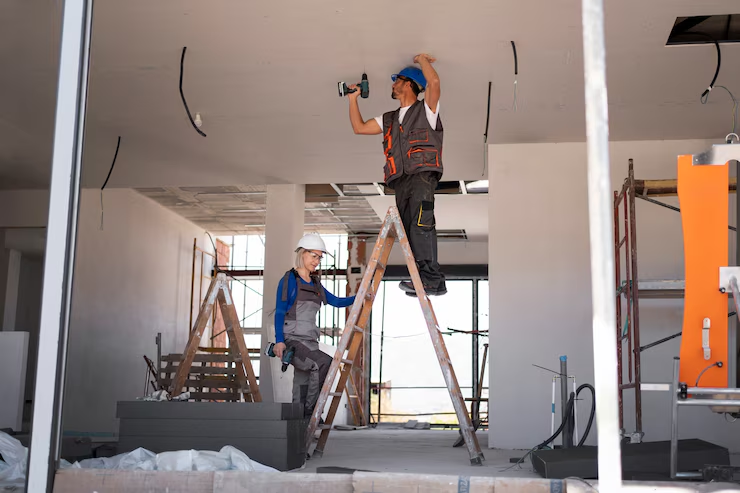July 12, 2025

A whole-home refurbishment is a significant undertaking that can completely transform your living space and lifestyle. Whether you're upgrading for better functionality, improving energy efficiency, or restoring a dated property, a full-scale renovation requires careful planning and strategic decision-making. Without a clear roadmap, it’s easy for costs to spiral, timelines to shift, and stress to mount.
From setting a realistic budget to navigating planning permissions, understanding the top priorities before starting can save you time, money, and headaches. This article offers a detailed look at the critical areas to focus on when planning a whole-home refurbishment in the UK.
Before you engage any professionals or spend a penny, define what you want to achieve with your refurbishment. Are you optimising for modern living? Adding space for a growing family? Increasing property value before a sale? Your goals will directly influence every decision—from the scale of the project to the materials you select.
Establishing a clear vision ensures alignment with your architect, builder, and designer, helping all parties work toward a unified outcome.
Budgeting is one of the most critical elements of a whole-home refurbishment. Not only should your budget reflect what you’re comfortable spending, but it must also be grounded in real-world pricing.
A robust budget prevents unpleasant surprises and allows for informed trade-offs when needed.
A successful refurbishment requires a team of qualified professionals. Trying to manage everything independently may lead to mistakes, delays, or compliance issues.
Key professionals might include:
Choose professionals with experience in full-home refurbishments, and check references and portfolios. Early involvement allows them to influence planning, design, and budgeting in a meaningful way.
Not all refurbishments require planning permission, but many do—especially when altering the exterior, changing structural layouts, or adding extensions.
Skipping this step can result in hefty fines, rework, or issues when selling the property.
Refurbishment projects often involve multiple phases. It’s essential to start with the fundamentals before moving on to finishes or decorative elements.
Focus on:
Neglecting the basics can compromise the entire project and lead to costly fixes down the line.
One of the advantages of a full-home refurbishment is the opportunity to reconfigure the layout to suit modern living.
This is where working closely with an architect pays dividends. A thoughtful layout can make even modest homes feel spacious and functional.
Material selection impacts durability, aesthetics, and environmental performance. Resist the urge to cut corners—what you save upfront may cost more in repairs or replacements later.
A sustainable refurbishment can reduce long-term costs and your home’s carbon footprint.
Whole-home refurbishments typically take 4 to 12 months, depending on complexity. Larger projects or those involving listed buildings may extend beyond that.
Key scheduling considerations:
Create a detailed timeline with milestones and communicate regularly with your project manager to keep things on track.
Refurbishing an entire home can be disruptive—especially if you plan to live on-site during the works.
Options include:
Factor these costs and logistics into your initial planning. Comfort and safety should not be compromised.
Once the major works are done, attention turns to finishes, fixtures, and final styling. These details can transform a solid build into a truly exceptional home.
Resist the temptation to rush this final stage. Your home’s look and feel will be defined here.
Most projects take between 4 to 12 months, though more complex renovations—such as listed buildings or major structural alterations—can take up to 18 months or more. The timeline depends on the scale, planning approvals, contractor availability, and weather.
In many cases, internal refurbishments fall under Permitted Development Rights and do not require formal planning permission. However, if you're altering structural elements or making significant changes to layout or use, consult with your local planning authority.
It’s possible but may not be comfortable or safe, especially during major works like rewiring or plumbing. Some homeowners choose to live in part of the house if the project is phased, while others move out temporarily for convenience.
Start with referrals, professional accreditations (like RIBA or FMB), and review portfolios of past work. Interview multiple professionals and ensure clear communication before signing contracts. Look for experience with projects similar in scope and complexity to yours.
Avoiding these pitfalls comes down to thorough planning and expert guidance.
A well-planned whole-home refurbishment can offer incredible results, both aesthetically and functionally. But success doesn’t happen by chance. Prioritising your goals, budget, legal compliance, team selection, and design strategy ensures you make the most of your investment.
By focusing on these top priorities and working with trusted professionals, you can transform your property into a modern, efficient, and beautiful space that meets your current needs and future aspirations.
Whether you're restoring a period home, modernising a dated layout, or preparing your house for resale, a full-home refurbishment is your chance to get it right from the ground up—strategically, sustainably, and smartly.
Ready to bring your home renovation or extension vision to life? At Milkov & Son Construction, we specialise in Architectural Design, Design & Building Process, Loft Extensions & Conversions, Extensions, House Refurbishments, and Interior Design. Whether it’s a single room makeover or a complete transformation, our expert team is here to guide you every step of the way. Contact us online or call +44 7951 625853 to start your project today.
